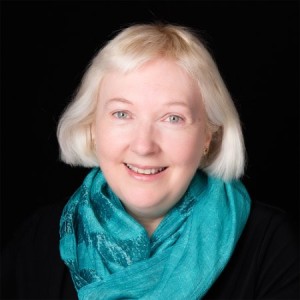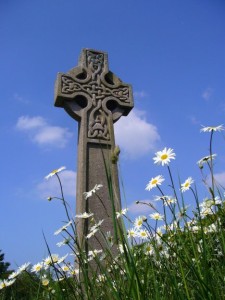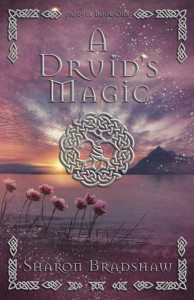Did some Druids survive the Romans’ attack c. 60-61AD? History is written by the victors, and my blog guest this week, historical fiction author Sharon Bradshaw, challenges certain “facts” people accept about history in the British Isles.
~~~
 Relevant History welcomes Sharon Bradshaw, a historical fiction author, storyteller, and poet. Sharon loves reading archaeology books and talked to a lot of monks in the 8th century while writing the Durstan series. A Druid’s Magic is set in the real Middle-Earth we called the Dark Ages. Subscribers to The Storyteller’s Newsletter receive a free short story from her every month. Sharon lives with her family and a large collection of books near Warwick Castle, in the UK. To learn more about her and her books, visit her web site, and follow her on Facebook and Twitter.
Relevant History welcomes Sharon Bradshaw, a historical fiction author, storyteller, and poet. Sharon loves reading archaeology books and talked to a lot of monks in the 8th century while writing the Durstan series. A Druid’s Magic is set in the real Middle-Earth we called the Dark Ages. Subscribers to The Storyteller’s Newsletter receive a free short story from her every month. Sharon lives with her family and a large collection of books near Warwick Castle, in the UK. To learn more about her and her books, visit her web site, and follow her on Facebook and Twitter.
*****
I write the Durstan series about a young monk in 794AD on the Hebridean island of Iona. The early Medieval period (500AD–1000AD), which I had been taught at school to call the “Dark Ages,” wasn’t dark at all. It was a rich and magical place where spellcasting and superstition were rife. A pantheon of old gods existed from the Iron Age, and before.
 People believed in the existence of elves, faeries, and dragons in a way that was not so far removed from J.R.R Tolkien’s Middle-earth. All of this was reflected in Anglo-Saxon and Celtic art, jewelry, and weapons; ancient place names; and a belief in destiny woven through the threads of the Wyrd. The monks themselves were regarded as spellcasters. The letters they wrote were similar to the marks made by a Druid’s runes.
People believed in the existence of elves, faeries, and dragons in a way that was not so far removed from J.R.R Tolkien’s Middle-earth. All of this was reflected in Anglo-Saxon and Celtic art, jewelry, and weapons; ancient place names; and a belief in destiny woven through the threads of the Wyrd. The monks themselves were regarded as spellcasters. The letters they wrote were similar to the marks made by a Druid’s runes.
.
Monasteries and the early Church
I was also taught that everyone converted to Christianity as soon as it arrived in the British Isles. Yet the further I delved into the past, the more it became clear. Christianity had stood for centuries side-by-side with belief in the ancestors’ gods. The Synod of Whitby in 664AD highlighted the depth to which diversity in belief ran at that time. Not only was there a pantheon of gods, all of which was not necessarily followed by every individual, but differences existed within the Church itself. Easter was celebrated on separate dates by Celtic and Roman rival followings, and a monk’s tonsure was cut in a way which depended on whether he followed St. John or St. Peter.
Despite the 4th-century Benedictine rule being recognised by the Iona monastery, Lindisfarne, and others, the rule wasn’t strictly observed until after the Norman Conquest. Until then, an abbot could run a monastery however he chose. Monks married and fathered children, ignoring the vow of chastity, while monks and nuns could live together as they did in Whitby. If that wasn’t enough, the Vikings brought their own gods with them when they raided Lindisfarne in 793AD and later settled in the British Isles.
What happened on Anglesey?
 Many believe that all the Druids were massacred by the Romans during the Boudican revolt c. 60-61AD. Druids in Gaul had been obliterated earlier, and historians relied for centuries on a sparse account by Tacitus (56–120AD) of what happened on the island of Anglesey. He didn’t write from personal experience, and his work is no longer regarded as impartial. Sadly the Druids didn’t leave behind an alternate version of events for us to read. Nor did they use a form of writing which would have enabled them to do so.
Many believe that all the Druids were massacred by the Romans during the Boudican revolt c. 60-61AD. Druids in Gaul had been obliterated earlier, and historians relied for centuries on a sparse account by Tacitus (56–120AD) of what happened on the island of Anglesey. He didn’t write from personal experience, and his work is no longer regarded as impartial. Sadly the Druids didn’t leave behind an alternate version of events for us to read. Nor did they use a form of writing which would have enabled them to do so.
Celtic Ireland
A number of Druids fled from the Romans during the first century AD to seek refuge in Celtic Ireland, which remained free from occupation. They played an important part in its mythology and became counselors to kings and respected prophets. Early Irish law confirms their decline as Christianity spread, but these men were still regarded highly in the 6th century when they taught the Aethelings. It’s possible that they traveled again through the British Isles, in particular after the Romans left in 410.
We know that some of their order joined the Church. Adomnan, Abbot of Iona (628–724AD) and biographer of St. Columba (521–597AD), attributes the saint with many qualities of a shaman: weather magic, miracles, second sight, and angelic apparitions. St. Columba came from a Druidic background in Ireland. Other saints were similarly attributed with these magical qualities, which remained an important part of the belief system in Anglo-Saxon Middle Earth.
The Druid bards
The bards told their stories when there was a feast. Beowulf and fragments in the 10th-century Exeter Book are thought to be examples of earlier tales from the 7th-century mead halls. A warlord who had yet to convert to Christianity would have welcomed the man or woman who could read the stars better than himself and converse with the gods. Even better if there was a tale or two to be told.
Despite no longer being leaders of Celtic society in the early Medieval period, the descendants of the Druid bards kept traditional beliefs alive in their tales of the past, while belief in the gods and goddesses of old survives today. You’ll find it in our long history of storytelling, folklore, and legend.
*****
 A big thanks to Sharon Bradshaw! She’ll give away one ebook copy of A Druid’s Magic to a reader in the UK who contributes a comment on my blog as well as one ebook copy to a reader in the United States who contributes a comment. I’ll choose the two winners from among those who comment by Tuesday at 6 p.m. ET.
A big thanks to Sharon Bradshaw! She’ll give away one ebook copy of A Druid’s Magic to a reader in the UK who contributes a comment on my blog as well as one ebook copy to a reader in the United States who contributes a comment. I’ll choose the two winners from among those who comment by Tuesday at 6 p.m. ET.
**********
Did you like what you read? Learn about downloads, discounts, and special offers from Relevant History authors and Suzanne Adair. Subscribe to Suzanne’s free newsletter.
